It’s snow-season in the Himalayas, and you’re wondering whether you should partake in the extreme adventure by taking your bike out on a spin. Should you do it? Is it too dangerous? This question has a lot to do with your personal preferences.
Still, you should know that it is not a general recommendation to ride a motorcycle with below-freezing temperatures as the motorcycles are smaller vehicles. Hence, they are more susceptible to ice.
But, if you are an adventure junkie and very eager to experience the thrill of extreme weather, then you must be educated enough to take the necessary precautions. Remember, being callous about your safety is not only a risk to you but also to anyone else on the road not only up in these remote roads of the Himalayas but anywhere.
You must prepare for it. Do know that you’re likely to hit the ice, slide, and face black ice on the roads. Snow might get into your shoes and create havoc on your core temperatures as well.
Let's quickly dive into the details:
Things to keep in mind for a cold-weather motorcycle ride
Before we get to the things you’d need, let’s first discuss a few basics of a cold-weather motorcycle ride
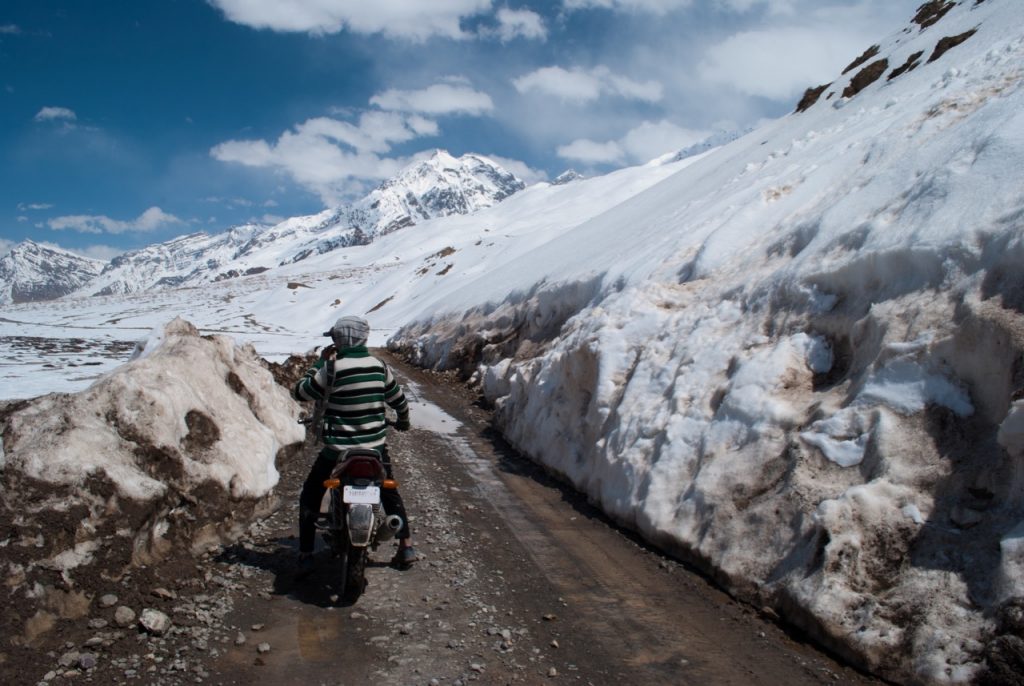
Air temperature vs Ground Temperature
The wind-chill is a real thing. And even if the ground temperatures sound decent enough to ride, don’t forget to factor in the air temperature. Without the proper gear, riding in sub-freezing temperatures is a huge risk as hypothermia will be a deterrent. When you ride in cold weather, the air is constantly taking away your body heat faster than what your body can produce. So your internal temperature starts dropping.
The Ground temperature is also important. If the ground temperature is freezing, chances are you’ll come across black ice. Black ice is a transparent sheet of ice that forms on the surface of roads. When ice gets wet from outside temperatures warming up, it becomes dangerously slick. Tires can’t provide the proper traction needed to grip the road, and that’s when accidents happen.
If you do unintentionally hit a patch of black ice, remember that you should never break the journey. If you press the brake paddle, your tires will not be able to stop, due to the slick nature of the surface. And, it can result in very disastrous scenarios. The best option is to drive slow in such conditions keep as much control as you can on the vehicle.
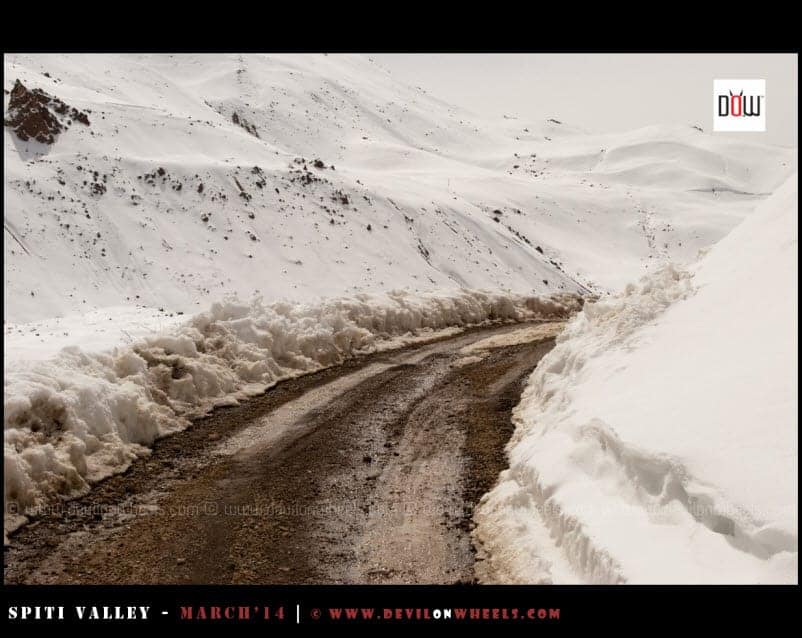
Define limitations
If your inner dialogue is psyching you out regarding the weather being too difficult, it is best to listen and stay put. Some other riders might have a different take – don’t push yourself based on what others feel comfortable in doing such extreme winter trips to Ladakh or Spiti.
Also, you should know the limitations of your motorcycle. Many motorcycles are not of the same caliber to manage, especially in cold weather. You should take that into cognizance.
Proper Gear
Goes without saying, proper gear is important when you’re riding long distances in general. However, if you’re taking on cold-weather adventures on a motorcycle up there in the Himalayas – you should be FULLY prepared.
A speck of snow here, some frigid rain there, and you’ll be cursing the day you decided to take on the journey. If you are prepared, however, most things can be managed with some presence of mind.
Must-haves for your cold-weather motorcycle ride
Okay, with all the precautions in mind, if you are still willing to give it a go, here are some things to get you fully prepared.
Helmet
The helmet is the most important part of biking. There should be ventilation as well as sufficient protection on the inside. This helmet is one gear where you should not be stingy with the cost. If the protection provided is spectacular, don’t be afraid in investing in a good helmet. Also, the helmet must be full-coverage. Anything less than that will not be sufficient.
The full coverage will help you keep the warm air trapped inside, so it is worth it to let go of some freedom. The cold air will not let you go very far if you’re not fully covered, especially your face. Some of my rider friends say that they let their hair get a little longer in winter to help keep their heads warm.
Travel Tip: Don’t forget to check my list of things to carry on a trip to Ladakh or Spiti valley.
Balaclava
One of the most common areas where gaps occur on a rider is around the neck, and because your jacket will extend only so far up and your helmet so far down, there are bound to be some spots that don’t get covered. That is where a good scarf or Balaclava will be a lifesaver. By wrapping the garment of choice around your neck, you’re sure to keep the wind at bay.
If you are not comfortable with Balaclava to go ahead and wrap your scarf around your head as well as your neck. Doing so will help you out two-fold because you’ll not only keep the wind out of the gaps around your neck but also, you’ll provide an extra layer of warmth inside your helmet.
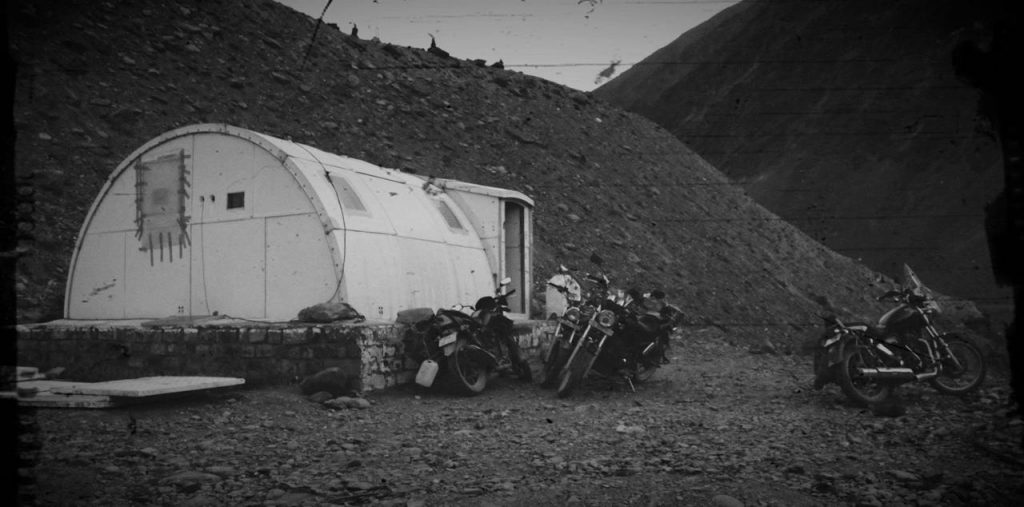
Jacket
A good jacket will be made of synthetic material, synthetic-blend, or leather. All these materials will do a good job of deflecting wind. But, remember, leather doesn’t protect as well against rain. No matter which you choose, make sure you look for something that has elastic cuffs along the wrists, waist (for both jacket and pants), and ankles.
These cuffs will make sure that you don’t get any errant wind slipping through your clothes and making you cold. Go for a good biking jacket that saves you from cold as well as rain.
As, if It rained or snow, it’s going to make you wet and you will shiver and have to cut short your ride. A jacket with spine support is a good investment. Remember that during the winter months, it is especially easy for your body parts to jam up. A good supportive jacket will help you maintain form while keeping warm.
Gloves
Are gloves essential? That’s what most of us think when thinking of bike rides – they seem restrictive, and your reflexes might not be the same as when you’re directly controlling the bike with your bare hands, right?
Well, wrong! I say you must always invest in good gloves. First, make sure it’s windproof. Anything else will be pretty much worthless on your cold winter months’ motorcycle rides.
And, we know that keeping that cold air off your hands is of the utmost importance up there in the remote Himachal or Ladakh – Zanskar region. Second, look for gloves that have some clasp or elastic at the wrist so you can close them tight around the long sleeves of your jacket or base layer.
Again, this closure is to keep the wind out. Finally, look for insulated gloves that will help keep you warm throughout your ride, and you can also try putting doctor gloves before biking gloves, as it would be an added layer of protection, and they won’t let any air in.
Shoes and Socks
The cold will send your body into survival mode. What that means, in part, is that most of your blood is going to rush to your major internal organs, so they’ll keep pumping along to make sure you’re still alive. As that happens, the blood flow to your extremities, such as your feet, will decrease, and with less blood, you’ll have less warmth.
Thus, in cold weather, your feet are far more likely to be affected by the cold than other parts of your body. Therefore, you must keep them nice and warm. The two best friends for your feet are a good pair of boots and comfy socks.
Planning to self-drive up there? If yes, do check out this list of must-have things to carry on a self-drive Himalayan trip.
When you’re searching for a good pair of boots, Quechua and Forclaz is the best but, do make sure that they are wind-resistant and waterproof. Carrying good shoes will ensure that you can keep all that cold air and rain away from your feet. Also, make sure they’re comfortable, Socks should be wool to keep your toes and feet very warm inside your boots. You can layer a couple of pairs of socks if you’re not able to heat your pinkies!
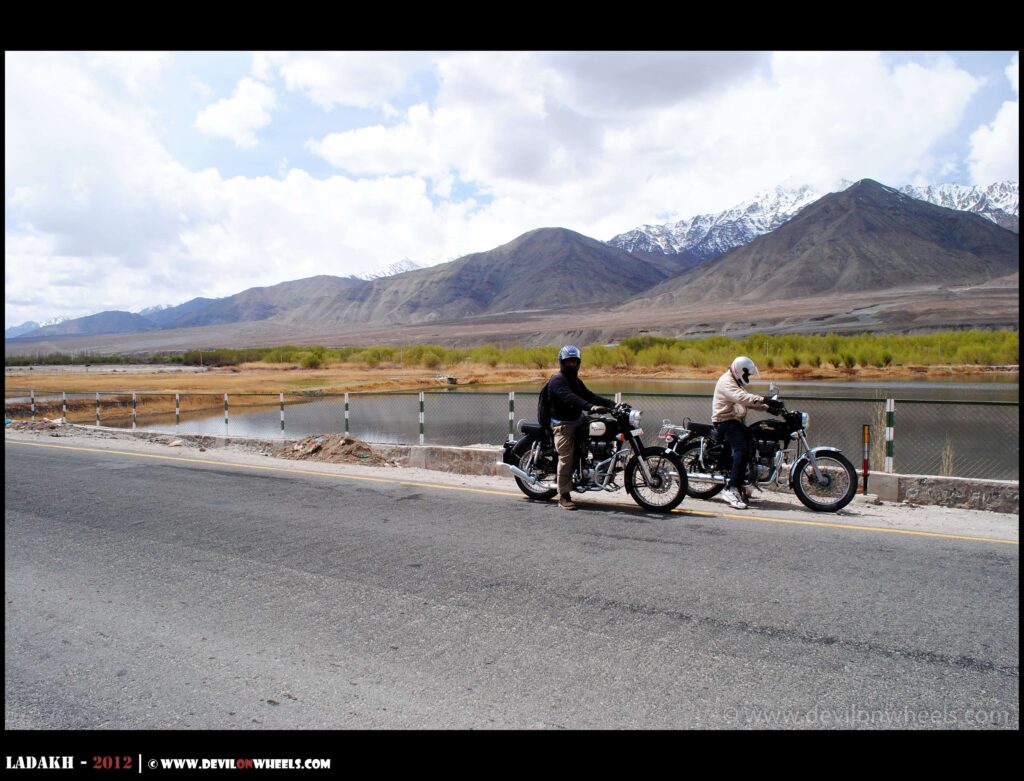
Pants
I will suggest you Go for Riding Pants and you MUST layer up with some warmers. These are especially important for your legs as legs are going to be struck by cold air and weather up there in cold Spiti or Ladakh conditions.
Warmers
Having a good base layer is one of the more important aspects of keeping warm when riding in the winter months because it’s the last layer of protection you have against the cold and biting winter winds you’ll face.
Always wear a good warmer beneath so you feel cozy and comfortable from inside. The moment the cold air hits your chest, you’ll start shivering. This issue will impact your ride. So, you must always be packed under your shirt and jacket! This packing will ensure another added layer of protection while keeping you cozy and warm in these extreme winter trips.
There is no shame in wearing these, and it will only add to your comfort, ensuring you get to enjoy the experience! Remember, more layers = more warmth.
You ride
For winter bike trips, you should avoid Fuel-Injected and Bikes without a kicker. Best are those old school kick start bikes with carbs. The reason is with such cold conditions; your battery will likely go kaput (at least temporarily).
So without your battery, a bike that relies too much on electronics will suffer much more than old school bikes. Avoid sports bikes with couched riding positions. Best are cruisers.
Many would say bullets are best suited for Himalayan trips. But for me, a V1 or V2 Unicorn is the best. A mono-shock bike, a smooth butter engine, an 18-liter fuel tank with an average mileage of around 45 kmpl in the hills having a range of 900+ km on a tank full at a weight of 140 kgs with a relaxed riding position, what more does a Himalayan rider need?
Fuel
Keep tanking the fuel, don’t hope that you will refill on the next pump, maybe it is not open. SO DONT DELAY. Also, carry spare engine oil and make sure you get an oil change at the 750 KM mark. Engine oil drains exponentially faster in such conditions. Do check your engine oil after parking your bike for a whole freezing night – it will be of extremely thick consistency! Let your bike warm up sufficiently in the AM.
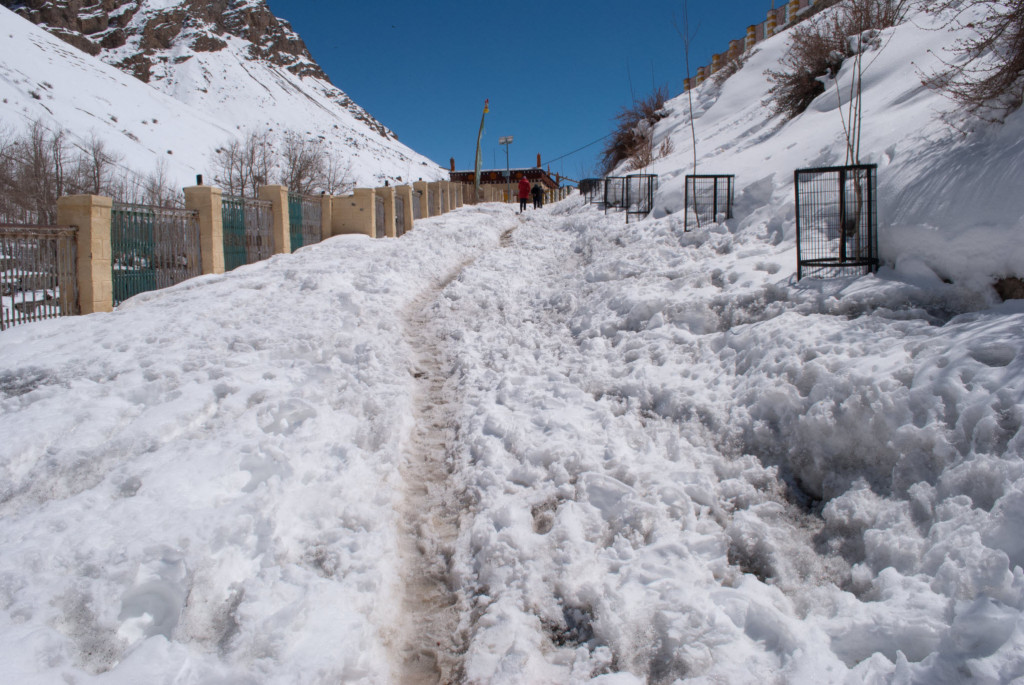
Hydration & Sustenance
Above all else, bikers get dehydrated much faster than people traveling in cars and in sub-zero temperatures, you can. And even though you might not feel like consuming water – you must! So, have tea whenever possible and, if possible, try having hot water.
The warmer the water, the more you can drink to keep you hydrated. Also, anything with garlic in it helps with breathing better. Feed yourself some piping hot soup and ask for loaded garlic while you’re at it. It will help you protect from high altitude sickness as well.
Also, it might seem contradictory but have as much sugar as possible. You will be amazed at the rate your body will start burning sugar from day 2 or 3 of your trip once it adapts to those temperatures. Sugar candies and dry sweets are best suited.
It is another good reason to have as much Chai as you probably could. It has sugar, heat, water, and milk (fat) all the necessary ingredients to keep you warm on the inside.
Other tips for the road
- Drive slow on Black ice, keep a keen eye to spot black ice or frost. This phenomenon is especially true in early mornings or late nights when the roads experience minimal traffic.
- If you are not able to maintain a good grip, and your bike is skidding a lot, then try deflating tires a bit. Deflation will help you a ton because your tire will now have more surface area in contact with the road. Don’t overdo it, though. Remember, if riding in the cold is difficult – fixing tires and issues with the bike will be a pain in the butt.
- Remember to carry an extra spark plug, a tire tube & puncture repairing kit as well as electrical tape (helps to tie up anything) and a tire Valve. Another important thing has to be the clutch wire. I have been at suffering end many times; this is essential.
- From personal experience, I can tell you that during winters, especially in the high altitude deserts, climatic conditions become exponentially unstable after around 3 PM. Avoid riding after 3 PM and make sure you avoid riding at all costs after 5 PM.
- If you’re in a situation where you face a snowstorm, NEVER TEND TO WAIT IT OUT. JUST KEEP GOING TO LOWER GROUND. A good reason why you need a tent.
- Avoid rushing. Yes, there are times we have to rush, but if there isn’t a dire need, try avoiding pushing yourself and your bike too hard. Remember, we are on a journey, not on a cross-country race. Make sure to take pit-stops wherever possible.
- Hand Warming Packets – you can even put a couple into your warmers to generate extra heat if your body temperature refuses to come up

Other Articles in Spiti – Ladakh Bike Ride Series
- Preparing your bike for Ladakh or Spiti trip
- The Complete Guide: Long Distance Motorcycle Riding
- Packing List for long-distance motorcycle riding
- Safely Carrying Spare Fuel & Luggage on Motorcycle
- Clothes & Accessories to Carry on Ladakh Bike Ride
- Tips for Tackling Water Crossings on Ladakh – Spiti Bike Ride
Conclusion
Winter months’ motorcycle rides are an extreme adventure. If you have your heart set on exploring the Himalayas in the winter months, you must proceed with precaution and care. Be prepared and most of your journey will be smooth sailing.
Have a travel question?? You can follow me on Instagram and subscribe to my YouTube channel to ask your travel questions in a direct message on Instagram or comment on my YouTube videos.
Also, do know that you WILL face challenges, you will curse yourself when you’re doing it at certain moments. But, if you have your heart set on achieving this milestone – the only way to do it is by being well prepared.
Have you traveled the Himalayas on a motorcycle in the winter months? Do share your experiences below!





